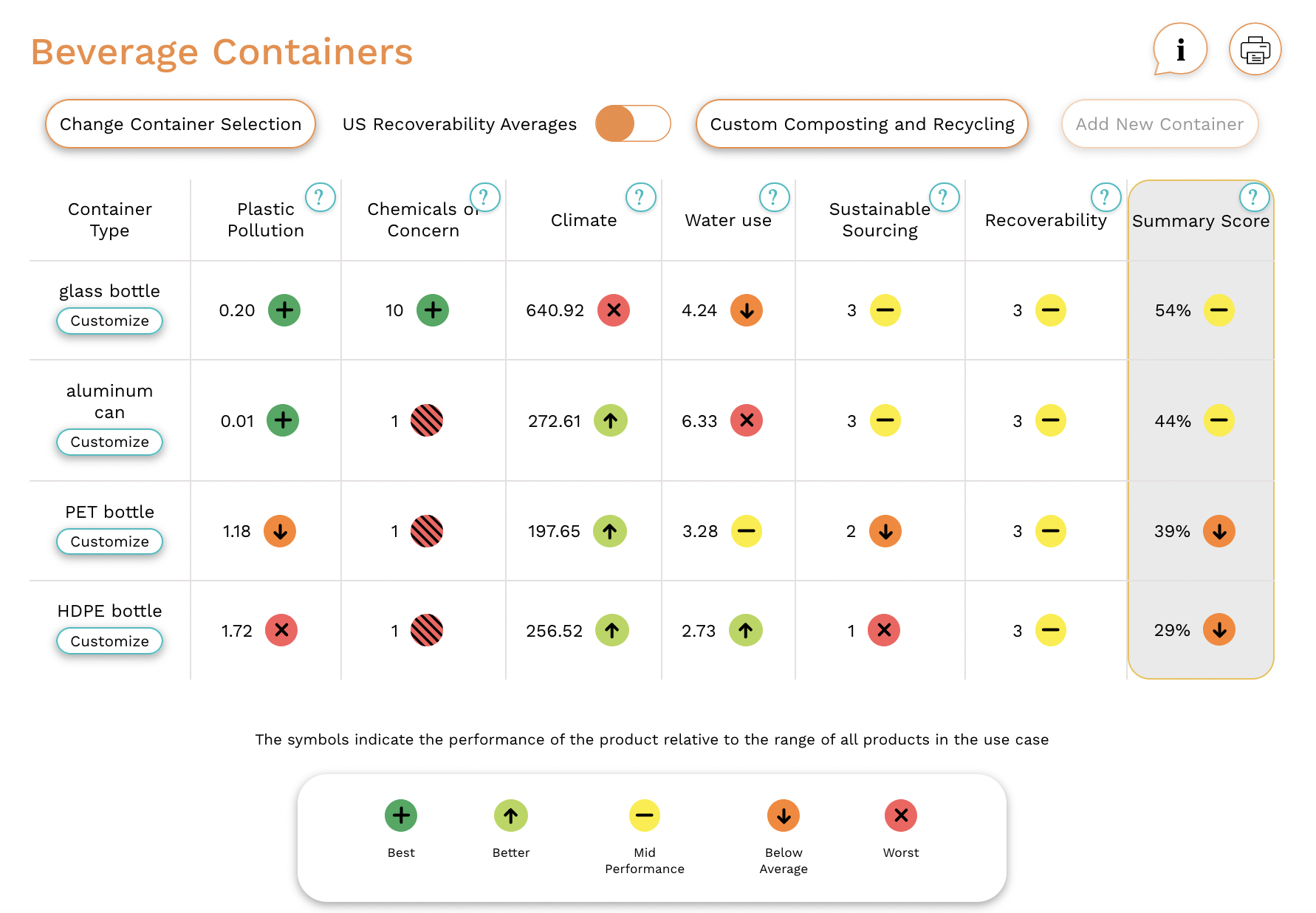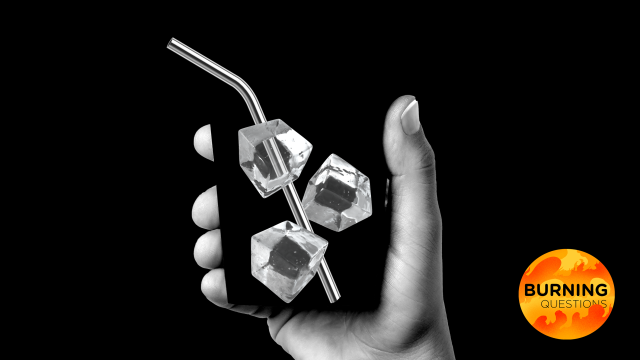Welcome to Burning Questions, a series where Gizmodo answers the most common asks we get on how to address climate change. Many people want to do something, anything to help address the climate crisis. We answer your questions about how to help change your life — and the systems that will save us. Check out our past Burning Questions here.
I almost never buy bottled water, but the other day, I found myself passing the grocery store after a two-mile (three-kilometre) walk in the blazing hot sun and needed a drink in a bad way. Perhaps because the shop was slightly bougie, the options were bonkers. Rows of plastic and glass bottles sat next to aluminium cans and cardboard cartons of water in the fridge, the latter two of which were branded with bullshit-seeming green branding. I chose a sleek aluminium bottle of water simply because it was the coolest to the touch. After chugging it in two gulps, I turned it around to read the marketing language stamped on it: “Plastic bottles are a huge problem. So here’s to one less.”
You don’t have to convince me that plastic is bad. But is aluminium any better? What of glass or cardboard that’s become increasingly trendy thanks to Jaden Smith? Is there an ideal choice if you also one day find yourself parched at the end of a two-mile walk?
A Brief Recap of Plastic’s Many Woes
Let’s first consider plastic bottles. Producing them — extracting raw fossil fuels, refining said fuels, then putting them into a steam cracker to turn into plastic — produces pollution that threatens the climate and public health. Each of these steps of production has particularly harsh impacts on low-income communities.
Transporting plastic to retailers is a relatively efficient process because it’s so light. And plastic’s problems don’t stop when you throw it out. Dumping plastic in landfills and incinerators releases hundreds of millions of tons of greenhouse gases. What doesn’t make it into those waste channels also creates issues. Research suggests that every minute, one dump truck load-worth of plastic gets into the ocean, where it’s gobbled up by animals and releases carcinogenic and endocrine-disrupting pollution.
In theory, you could recoup some of these negative impacts with recycled bottles, lessening the need for virgin plastic stocks. But in practice, not a lot of plastic recycling is actually happening. Globally, only 9% of all plastic waste ever produced has been recycled.
“There is no amount of cleanup, recycling, or any other means for dealing with post-consumer plastic pollution that will make these materials sustainable; especially as plastic producers continue to increase the amount of single-use plastic products being produced,” Dianna Cohen, CEO of the Plastic Pollution Coalition, said via email.
Considering the Alternatives: Glass, Metal, Cardboard
The glass supply chain isn’t free of environmental troubles. It’s made of sand, which is a surprisingly scarce resource, accounting for 85% of all mineral extraction on Earth. Glass production is also an energy-intensive process, accounting for 1% of total industrial energy use, and it’s mostly fuelled by polluting natural gas. It’s also heavier than plastic, so it’s less efficient to transport. But on a positive note, 33% of it is recycled, a much higher rate than plastic. And glass can be infinitely recycled without losing quality.
“Plastic bottles are usually downcycled, meaning turned not into food-grade products but into carpeting or fiberfill,” Kelley Dennings, a campaigner at the Centre for Biological Diversity, said. “Glass can be recycled into glass.”
Then there’s aluminium, which is refined from bauxite. It’s a rock typically strip-mined, which removes native vegetation, destroying local habitats while also making erosion more likely. The process can also pollute water sources. And in places like Guinea, mining bauxite has led to ancestral farmlands getting expropriated.
Aluminium production is also more energy-intensive than plastic or glass. In terms of transportability, it’s somewhere in the middle — a can is lighter than a glass container but heavier than a plastic one. But it’s the best in one clear way: Its recyclability rate is about 50%, which is the best of the three, and it too can be infinitely recycled.
Even boxed water has problems — sorry, Jaden. Analyses show that single-use paper products put pressure on global forests, which are home to much of Earth’s biodiversity, sustain Native communities, and also, crucially, suck up carbon from the atmosphere, helping to cool the planet. They’re also usually coated in plastic or aluminium to prevent seepage, but that makes them impossible to recycle in most places.
There are other considerations when it comes to analysing the life cycle of a drink container: water usage; soil contamination; the risk of ingesting compounds in the bottles, like PFAS from plastic. Dennings said she wasn’t sure she could determine the least harmful choice.
“They’re all evil in their own ways,” she said.
OK, So What’s The Least Bad Water Bottle?
Many researchers have compared the impact of each material, with varying conclusions based on what aspects they focus on. One recent attempt is the Understanding Packaging scorecard, which considers the climate impact, water usage, plastic pollution, sourcing of raw materials, end of life and recovery practices, and the presence of chemicals of concern associated with different materials.

“You can see from the results that the glass bottle is the best option,” Cohen, who worked on the new scorecard, said.
So, raise a bottle of Voss or whatever your preferred brand of glass-bottled water is to your lips if you absolutely cannot drink tap water. But the most important question isn’t what you choose individually. It’s how we get to a point where we have better options.
“If someone is putting the energy into agonizing over what type of water bottle will do the least damage at the store, I would really encourage them to look into organisations that are working on waste and plastics issues either in your area or nationally and how you can contribute,” Aditi Varshneya, zero waste communities coordinator at the Global Alliance for Incinerator Alternatives, said.
How to Improve Our Water Choices
As you take a slug from your bottle of Acqua Panna, consider how to advocate for better choices and accountability for corporations who created this single-use mess in the first place.
One place to start is pushing for a comprehensive national bill like the Break Free From Plastic Act, which includes provisions to force plastic producers to manage and pay for recycling programs. States all over the country from Washington to California to Maine have passed bills to crack down on disposables, with many more in consideration. Advocating for these solutions will ensure everyone has better choices.
Dennings said that for inspiration, we could also look to recent history for a start. “I remember growing up in the 70s, taking my soda bottles back to the store to get refilled and sold again. Imagine if we had laws mandating that kind of thing,” she said. “There are ways that we could push governments to move toward … products that can be used more than once.”
Another idea is to pressure officials to bring back public water fountains so that people don’t have to buy single-use containers. That also means ensuring all people have access to clean potable water. (There’s a bill for that that you can advocate for, too.)
“In so many places, people are buying the plastic bottles because they don’t trust what’s in the tap,” said Varshneya.
